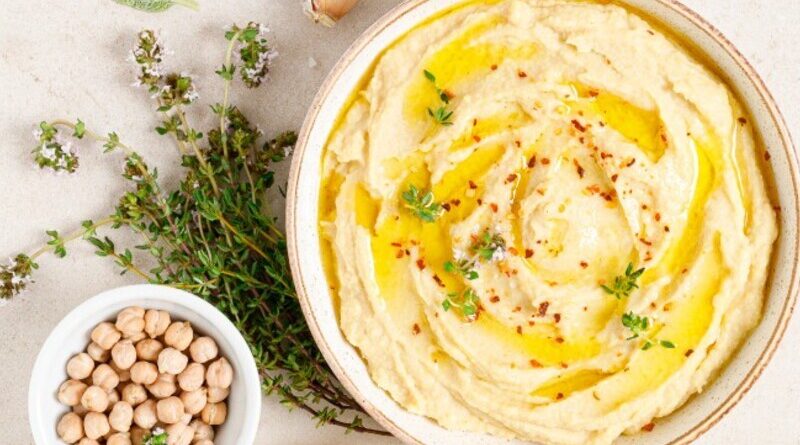Discover the Delight: Unveiling the Secrets of Healthy Hummus
Greetings from the delicious world of healthy hummus! This adaptable Middle Eastern dip has become very popular due to its delicious flavor and many health advantages. This post delves into the benefits of hummus, looks at its many forms, and offers advice on how to include it in your regular diet. Join us as we explore the techniques for creating and savoring the ideal hummus, regardless of your level of experience with this tasty delight.
Key Ingredients in Making Healthy Hummus
| Ingredients | Quantity |
|---|---|
| Chickpeas (Garbanzo Beans) | 1 can (15 ounces) or 1 1/2 cups (cooked) |
| Tahini (Sesame Seed Paste) | 1/4 cup |
| Lemon Juice | 2-3 tablespoons |
| Garlic, minced | 1-2 cloves |
| Olive Oil | 2 tablespoons |
| Salt | 1/2 teaspoon |
| Water | 2-4 tablespoons (as needed) |
| Paprika | For garnish |
| Fresh Parsley | For garnish |
| Extra-virgin olive Oil | For drizzling |
| Sesame Seeds | For garnish |
| Cumin | For garnish |
Variations and Healthy Hummus Flavor Enhancements
Because of its creamy texture and adaptability, hummus is a great base for a wide range of flavor combinations. Here are a few simple suggestions to improve your hummus experience:
Roasted Red Pepper:
For a smoky-sweet variation, blend roasted red peppers with standard hummus components.
Sun-Dried Tomato:
Rehydrated sun-dried tomatoes can be added to hummus to give it a delicious and tangy flavor.
Spicy Sriracha:
Add some sriracha sauce to hummus to give it a spicy kick that arouses the palate.
Herb-Infused:
For a burst of freshness, blend in some fresh herbs like basil, parsley, or cilantro to hummus.
Avocado for Healthy Hummus:
To add extra smoothness and a burst of healthful fats, mix ripe avocado with hummus.
Beet:
Beets can be roasted or steamed, then blended with hummus to make a colorful and nourishing dip.
Health Considerations: Allergies and Dietary Restrictions
It’s important to be aware of any dietary restrictions and potential allergies when enjoying the deliciousness that is hummus. Here’s a quick rundown:
Gluten Sensitivity or Celiac Disease:
Because hummus is inherently gluten-free and mostly consists of chickpeas and tahini, anyone with celiac disease or gluten sensitivity can safely eat it. But be sure the components in store-bought versions are free of gluten-containing additives by carefully double-checking them.
Nut Allergies:
Though some commercial brands may include nuts, traditional hummus recipes usually do not. If you’re allergic to nuts, make your hummus, or make sure to read the labels before you buy.
Sesame Seed Allergies:
For people who are allergic to sesame seeds, tahini, a crucial component of hummus, may be problematic. Look for hummus options that don’t use tahini or think about making your own with substitute ingredients.
Sodium Content in Healthy Hummus:
Salt is frequently added to store-bought hummus for flavor and preservation. If you’re watching how much sodium you eat, go for low-sodium options or make your hummus at home to minimize the salt.
FODMAP Sensitivity:
Some people may have gastrointestinal distress because of specific fermentable carbohydrates present in hummus ingredients, such as chickpeas. Although blending and boiling chickpeas can lower their FODMAP content, people who have sensitivity issues should only sometimes eat hummus.
Healthy Hummus as a Versatile Ingredient in Cooking
Hummus is a multipurpose ingredient that can elevate simple meals into delectable treats. It’s not only for dipping. Hummus has you covered whether you want to give your food a rich taste or a creamy texture. Spread it on wraps or sandwiches, mix it into spaghetti, or marinate meats and veggies in it. The choices are unlimited when it comes to hummus, and your taste buds are going to love it!
Incorporating Healthy Hummus into a Balanced Diet
Not only is hummus a delicious dip, but it’s also a multipurpose component that can improve any dish. How to incorporate it into your regular diet is as follows:
Snack Smart:
Combine hummus with whole grain healthy crackers or vegetables for a wholesome lunchtime snack.
Breakfast Boost:
For a savory breakfast variation, spread hummus on toast or stir it into scrambled eggs.
Lunchtime Delight:
Spread hummus on wraps or sandwiches, or combine it with grains and vegetables to make a filling salad.
Dinner Dazzle:
Use hummus as an ingredient in pasta recipes, marinate proteins in it, or have it as a side dish with your entrée.
Versatile Side in Healthy Hummus:
Hummus can be added to soups and stews as a thickening agent or served as a dip for snacks.
Homemade vs. Store-Bought: Making the Healthiest Choice
Make your hummus or purchase it from the shop; take into account aspects like freshness, quality, and personalization. Making your hummus gives you complete control over the components, maximizing freshness and reducing additives. To suit your tastes, you can change the nutrition and flavors.
Store-bought hummus is more convenient, but it could also have additional sodium and preservatives. Choose the healthiest option depending on what matters most to you: convenience, freshness, or flavor control.
Conclusion
In summary, hummus is a versatile and healthful complement to any diet in addition to being a delicious dip. Its combination of tahini, chickpeas, and different flavorings provides a wide range of flavors, from classic to creative. Additionally, because it is devoid of gluten and can be customized, it can accommodate a variety of dietary requirements and preferences. Hummus satisfies cravings and boosts nutrition whether it’s eaten as a spread, snack, or part of a meal. You can choose to make your hummus or buy it from the store, but either way, the experience will be tasty and rewarding.
